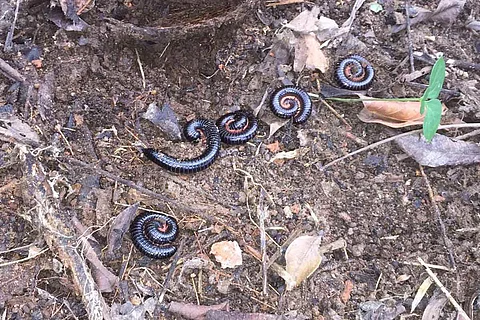

It’s an unnerving situation for about 10 families residing in Vellerichal village in Kozhikode district’s Kumaranalloor. Everywhere they see are millipedes, crawling around with their black bodies and numerous orange-coloured legs. A bunch of them are found in a bucket of water drawn from the well, some in the bedroom on the pillows, some on chairs, and some even in cooked food.
The families have approached the Karassery grama panchayat to take some measures against the millipede infestation they are facing. Every rainy season the village witnesses the arrival of these small creatures. But this time even before the onset of the monsoon, hundreds of them are appearing the very next day after every summer shower.
The harmless arthropods discharge cyanide gas along with benzoquinone, releasing an unpleasant smell if they are pressed or stamped upon.
“We five families draw water from a well here. We depend on the well water for cooking, drinking, washing clothes, etc. But for the last few days, every bucket of water drawn has at least 10 millipedes in it. They have also covered the edge of the well. So we have stopped taking water from the well. In the mornings when we wake up, we find them in our beds, many of them appear in our courtyard, kitchen and even inside the food. It has really become a problem to even walk in our compound. We are tired of dealing with this,” Shafeeq, a resident of Vellerichal, told TNM.
In some cases, the residents had to throw away cooked food after finding millipedes in it. “We have tried destroying them using kerosene and lime water. But that didn’t work out. Now we collect them in bottles so that they don’t get out. During the monsoon, their numbers will further increase,” another resident Ajay said.
Residents also complain that the millipedes are largely breeding in the fertilisers used by the rubber plantation nearby. Three years ago, the area was affected by the African snail menace, but the panchayat later used a chemical treatment to get rid of the snails.
“We’re going through a similar situation again. Immediate attention from the panchayat is required. It is very difficult to continue living here,” Shafeeq added.
Though there are reportedly about 80,000 species of millipedes in the world, only 10,000 have been described. Among them, 270 species are from India and 93 from south India. Millipedes are good decomposers and provide nutrients to the soil. They create compost by decomposing plant waste and also aerate the soil. However, inside homes they are a menace.
“In large numbers, millipedes are a menace. Other than that they don’t create any problems. In rare cases, they may cause an allergy if they come in contact with skin,” M Nasser, Professor, department of Zoology, Calicut University, said.
He also added that the millipede breeds only in organic fertilisers. “It can breed in organic fertilisers and also in latex with moisture content. There is no chance of them breeding in chemical fertilisers. So if the residents keep organic fertilisers away, it can solve the issue a bit,” he added.